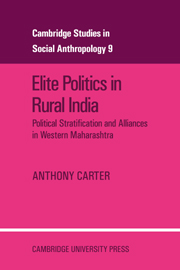 Elite Politics in Rural India
Elite Politics in Rural India from Part 2 - Aspects of political stratification
Published online by Cambridge University Press: 02 March 2010
In view of the importance of political stratification and elite circulation for an adequate understanding of contemporary Indian politics and of many aspects of Indian social history as well it is remarkable that so little has been written on the subject. There is a useful body of material on dominant castes, but so far it has been focused mainly on village dominance. Little is known about regional dominance or about dominance in more inclusive, higher level political arenas (see Mayer 1958a). Few of those who have written on dominant castes have broken through the overlay of issues related to caste to deal with the phenomenon of dominance per se (see Gardner 1968). Much of what has been written explicitly about dominance and stratification is based on secondary sources (e.g. Bottomore 1967) or upon the most casual sort of fieldwork (e.g. Beteille 1967). Although a number of historical and political studies use the concept of the elite (see Broomfield 1966 and 1968, Stokes 1970, Mukherjee 1970, Dobbin 1970, Rosenthal 1970, and, on Maharashtra, Johnson 1970 and Sirsikar 1970), in most such work
theory has been of minor relevance; the word ‘elite’ then implies no more than ‘the men at the top’, whatever the particular context of discussion happens to be.
(Leach and Mukherjee 1970:x)As a result, outside of the literature on village dominance there have been few detailed empirical studies of the social origins of Indian political leaders and of the relations between the mass of the electorate and the groups from which most such leaders seem to be recruited. A major aim of Part 2 of this essay is to fill that gap.
To save this book to your Kindle, first ensure [email protected] is added to your Approved Personal Document E-mail List under your Personal Document Settings on the Manage Your Content and Devices page of your Amazon account. Then enter the ‘name’ part of your Kindle email address below. Find out more about saving to your Kindle.
Note you can select to save to either the @free.kindle.com or @kindle.com variations. ‘@free.kindle.com’ emails are free but can only be saved to your device when it is connected to wi-fi. ‘@kindle.com’ emails can be delivered even when you are not connected to wi-fi, but note that service fees apply.
Find out more about the Kindle Personal Document Service.
To save content items to your account, please confirm that you agree to abide by our usage policies. If this is the first time you use this feature, you will be asked to authorise Cambridge Core to connect with your account. Find out more about saving content to Dropbox.
To save content items to your account, please confirm that you agree to abide by our usage policies. If this is the first time you use this feature, you will be asked to authorise Cambridge Core to connect with your account. Find out more about saving content to Google Drive.